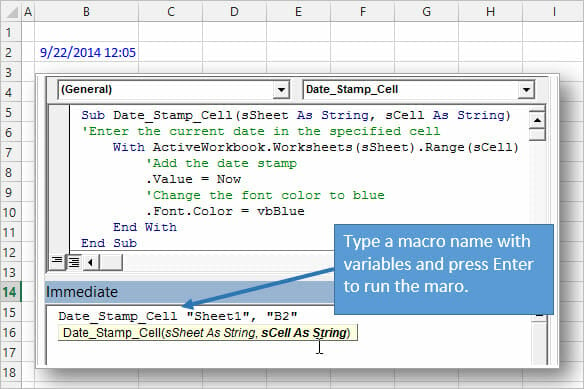
Vba Code To Set Calculation To Manually Add
WorksheetFunction ScreenUpdating DisplayAlerts Calculation
This code simulates the range that would show up if you were to use the keyboard shortcut Ctrl + Shift + Right Arrow and then Ctrl + Shift + Down Arrow. If the last cell in the first row or the last cell in the first column are empty, this code will not calculate properly. Back to: Excel Custom Function/Formulas While I would never suggest anyone use Manual calculation in Excel, I realize that many still do. All it means is you have Spreadsheet Design issue that you SHOULD fix rather than cater to. Excel Function For Calculation Status.
The mother of all objects is Excel itself. We call it the Application object. The application object gives access to a lot of Excel related options.
WorksheetFunction
You can use the WorksheetFunction property in Excel VBA to access Excel functions.
1. For example, place a command button on your worksheet and add the following code line:
When you click the command button on the worksheet, Excel VBA calculates the average of the values in cell A1 and cell A2 and places the result into cell A3.
Note: instead of Application.WorksheetFunction.Average, simply use WorksheetFunction.Average. If you look at the formula bar, you can see that the formula itself is not inserted into cell A3. To insert the formula itself into cell A3, use the following code line:
ScreenUpdating
Sometimes you may find it useful to disable screen updating (to avoid flickering) while executing code. As a result, your code will run faster.
1. For example, place a command button on your worksheet and add the following code lines:
For i = 1 To 10000
Range('A1').Value = i
Next i
When you click the command button on the worksheet, Excel VBA displays each value a tiny fraction of a second and this can take some time.
2. To speed up the process, update the code as follows.
Application.ScreenUpdating = False
For i = 1 To 10000
Range('A1').Value = i
Next i
Application.ScreenUpdating = True
As a result, your code will run much faster and you will only see the end result (10000).
DisplayAlerts
You can instruct Excel VBA not to display alerts while executing code.
1. For example, place a command button on your worksheet and add the following code line:
When you click the command button on the worksheet, Excel VBA closes your Excel file and asks you to save the changes you made.
2. To instruct Excel VBA not to display this alert while executing code, update the code as follows.
ActiveWorkbook.Close
Application.DisplayAlerts = True
As a result, Excel VBA closes your Excel file, without asking you to save the changes you made. Any changes are lost.
Calculation
By default, calculation is set to automatic. As a result, Excel recalculates the workbook automatically each time a value affecting a formula changes. If your workbook contains many complex formulas, you can speed up your macro by setting calculation to manual.
1. For example, place a command button on your worksheet and add the following code line:
When you click the command button on the worksheet, Excel VBA sets calculation to manual.
2. You can verify this by clicking on File, Options, Formulas.
3. Now when you change the value of cell A1, the value of cell B1 is not recalculated.
You can manually recalculate the workbook by pressing F9.
4. In most situations, you will set calculation to automatic again at the end of your code. Simply add the following code line to achieve this.
Excel workbooks can become quite complex. In fact, it is possible to create workbooks that can take hours to calculate. The only problem with this, of course, is that when you open a workbook, it automatically recalculates if you have Excel configured to do that. This means that just opening a workbook can, in some instances, take hours.
One solution, of course, is to turn off automatic recalculation before you open the workbook. If you are like me, this solution isn't that great because my memory isn't always that great.
A better solution is to turn off automatic recalculation for certain workbooks. Since Excel doesn't allow you to specify manual or automatic recalculation on a workbook-by-workbook basis, you will need to add this feature through the use of a macro that automatically runs when the workbook is opened. This macro can turn off automatic recalculation, as shown here:
This macro must be placed in the ThisWorkbook project window. This means that you should open the workbook, press Alt+F11 to display the VBA Editor, and then double-click on the ThisWorkbook object in the Object Browser (upper-left corner of the VBA Editor window).
If you want, you can also place another macro right after the previous one. This macro is run automatically when the workbook is closed and, in this case, turns automatic recalculation back on:
There is an important caveat to remember in relation to using this macro. You can only set the calculation mode for the application as a whole. Thus, with automatic recalculation turned off, no other worksheets will be automatically recalculated, either.
Mazhathullikilukkam film mp3 songs. Anna and Alice are sisters who are spinsters and they own the huge estate. The home nurse, Sophiya , cook , cook's son and the priest are the only people close to them. Soon, Soloman becomes the apple of their eye and they both consider him as their own son. Soloman takes charge as the manager of the estate and soon wins over the two oldies.He realizes that they are two angels and he tries to bring back joy into their morbid life. Meanwhile, he falls in love with the home nurse Sophiya with whom he had regular fights.